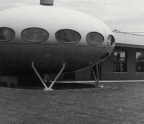A Dash through the Sahara

In this 1925 photo, Tuareg chiefs and members of the Beloit expedition to the Tamanrasset area of Algeria pay homage at the gravesite of Père Charles de Foucauld, a French Catholic missionary who lived with the Tuareg for ten years before he was martyred in 1916. Among the Westerners are Count Byron Khun de Prorok, right, Bradley Tyrrell, center with blonde hair, and next to him with a red tie, their driver, Martini. WHI IMAGE ID 135311
On October 12, 1925, an unlikely group of men set out on a “1,500-mile dash through the Sahara” in search of knowledge, artifacts, and adventure. The expedition, fueled by fierce competition and a quest for buried treasure, provided a new understanding of the Tuareg, a large, nomadic Berber ethnic group, and brought acclaim to Wisconsin’s Beloit College. For the contemporary reader, however, it brings up serious ethical concerns—and lessons—about archaeological and anthropological practice during the twilight years of the colonial era.
In the early part of the twentieth century, Westerners attributed levels of sophistication to cultures and civilizations based on their political systems. According to scholar Margarita Díaz-Andreu, Westerners considered complex state societies in Asia and North Africa to be more advanced than “those perceived as formed by savages and primitives, with the simplest types of political organization.” The Tuareg, with a nomadic lifestyle that did not include property rights and whose women held powerful positions, were viewed as a lesser civilization. In addition, by the end of the nineteenth century, the Enlightenment view of indigenous people as “noble savages” had shifted. So-called “primitive” societies were described by Westerners as “ignorant, backward and uncivilized,” and the fields of archaeology and anthropology were enlisted to support these beliefs. To differing degrees, the members of the expedition to the Sahara were informed by these attitudes, which are evident in both their actions and in first-person accounts written after their return.
The mission in the Sahara, which included two representatives from the college, Alonzo Pond and Bradley Tyrrell, laid the foundation for future archaeological digs sponsored by Beloit College, as well as the development of an impressive collection of artifacts and the establishment of a training program for its students. While Tyrrell footed his own bill, Pond, as head of the expedition, was sponsored by George Collie, then head of the college’s Logan Museum of Anthropology, and the venture was financially supported by trustee and donor Frank Logan, for whom the museum is named.
Born in 1894 into a Janesville, Wisconsin, family that owned a dry goods business, Alonzo W. Pond was much more interested in the natural world than the mercantile. The town’s noted naturalist, Halvor Skavlem, encouraged his interests and introduced him to archaeology, a field he embraced when he entered Beloit College in 1914, despite a lackluster academic performance in high school. Working at the Logan Museum, where he first met Collie, cemented his desire to pursue the field, though he departed in 1917 to serve in the American Field Service in France after landing on academic probation. In the service, Pond gained important skills that would prove crucial for his later work in the Sahara—driving an ambulance in less-than-ideal conditions, survival skills, and speaking French.

Pond returned to Beloit College in the fall of 1919 and managed to complete his bachelor’s degree the following semester. He and a friend then tried their luck running a small restaurant in Florida, but Pond was drawn back to academics when Collie recommended him for a scholarship at the American School in Europe for Prehistoric Study in Paris. He spent two years studying and conducting research before returning to the United States to begin a graduate program at the University of Chicago, switching his field of study from archaeology to anthropology.


Sidebar: The Pond
You’re reading a preview, subscribe to read more.
Start your free 30 days



